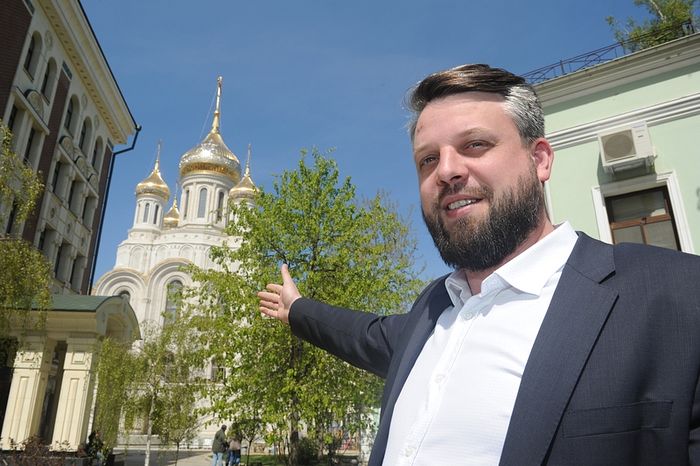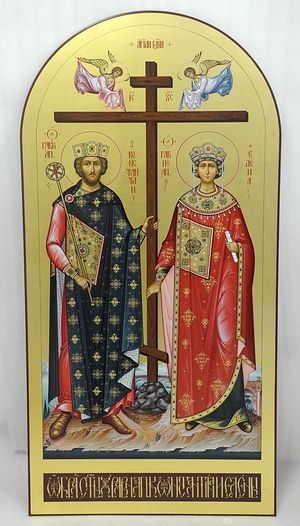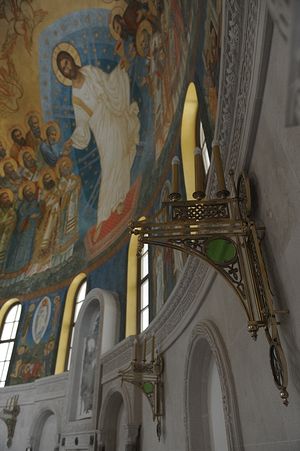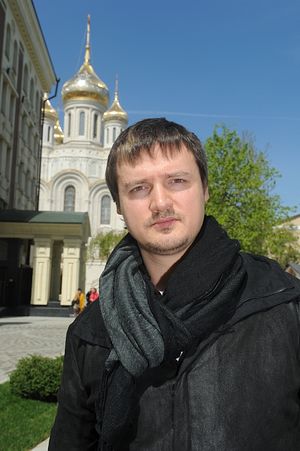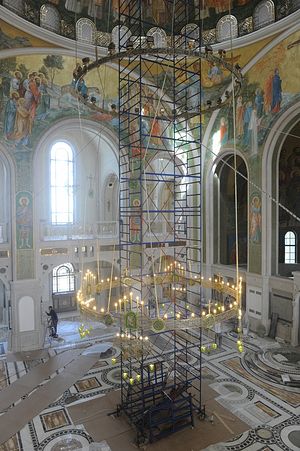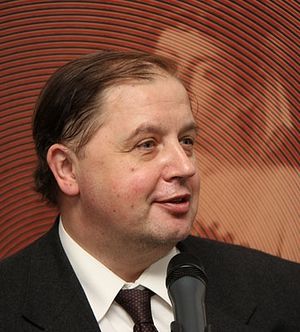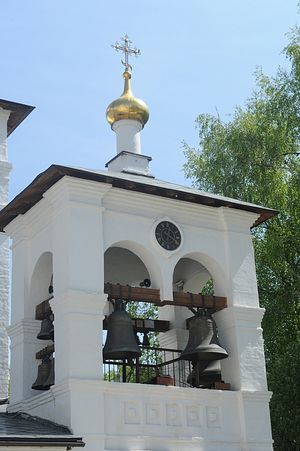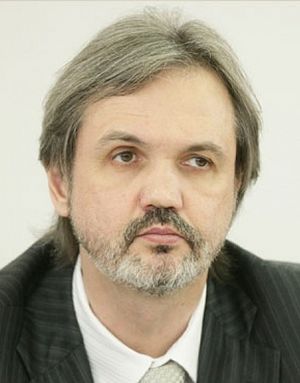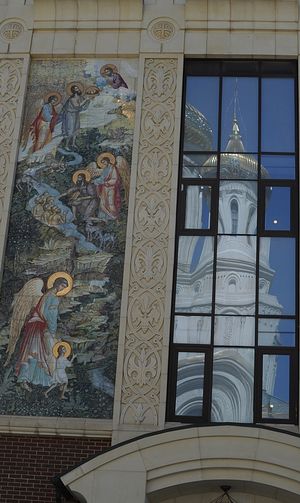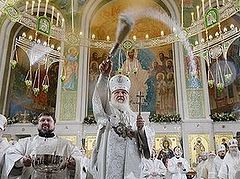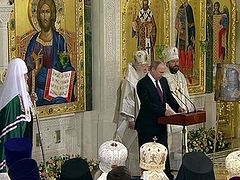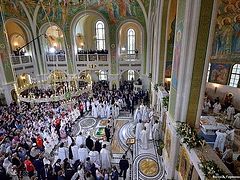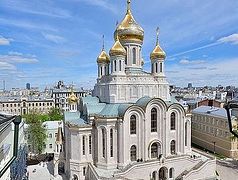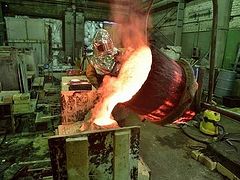The opening of a new church was a common occurrence in Moscow, a city which was formerly nicknamed “the forty forties”, or “the city of 1,600 churches”. But for the first time in many decades a new church has appeared in the capital’s historical center—at the Moscow Sretensky Stavropegic Monastery in Bolshaya Lubyanka Street. And it is an absolutely new church on this site.
The Church of the New Martyrs and Confessors of the Russian Church, which can accommodate up to 2,000 worshippers and has been built on a patch of land within the ancient monastery in an extremely short space of time, is unique both in its architectural merits and spiritual importance for the capital and for the whole country alike. It was consecrated by Patriarch Kirill on the feast of Ascension of the Lord, May 25, 2017.
It is symbolic that this remarkable event has taken place in the year when we remember the centenary of the Russian Revolution and mark the tenth anniversary of the reunification of the Moscow Patriarchate and ROCOR and the 620th anniversary since the foundation of Sretensky Monastery… A correspondent of the Kultura newspaper visited the construction site shortly before the completion of the work.
Those who have not passed or driven through Rozhdestvensky, Petrovsky and Sretensky Boulevards for some time lift their heads in amazement as they see a five-domed church, towering on the hill behind the first row of houses, as if appearing from nowhere. Domes with silver embossed crosses glitter with gold leaf in the Sun; there are arched windows and walls of white stone. How did this dominating structure come into existence?
Behind the barrier the air is full of dust, work is in full swing. Trucks are dumping sand which will be used to make paving blocks that will be laid on the square in concentric circles. Dozens of concrete edging machines are screeching, hammers are beating, welding is sparking. The scaffolding has already been taken down, the nave is complete and cleared up, while the side aisles and the stairs are still being decorated, painted and screens are being welded. The space for a mosaic icon of the Savior which will be 1.5 meters (c. 4.92 feet) long is being prepared on the north façade.
General director of the construction firm and the main builder of the church Kirill Lapshin offers a tour around the nearly completed edifice.
“Will we have time to finish? We have no alternative!” K. Lapshin says.
He unlocks the church’s side gate (which has a combination lock) with the depictions of saints in relief on them: those of St. Tikhon of Moscow and St. Hilarion (Troitsky) who once was abbot of Sretensky Monastery and in 1923 subjected to repressions.
“We are now standing in the altar area designed for holding open-air services, when the place is overcrowded,” my guide explains. “Our Bishop Tikhon (Shevkunov) has already celebrated the first Liturgy on this site. It was on March 15 (March 2 according to the old calendar) when we commemorated the day when the conspirators had forced the Holy Emperor and Passion-Bearer Nicholas II to abdicate. Around 2,000 worshippers listened, standing in the monastery courtyard.”
The people at Sretensky Monastery have endured many trials because of the construction of the long-awaited church. Attacks, attempts to discredit the idea and impede the progress appeared in great numbers from all sides. Opponents dubbed this project “a counterpart of the Palace of the Soviets”, accused priests of neglect of the city’s high antiquity, pride and modernism… Now all of this is gone. The criticism has been forgotten, while the magnificent cathedral has remained. By the way, Bishop Tikhon has donated all proceeds from his best-selling book Everyday Saints and Other Stories to the construction of the temple.
The church was built like in a fairy-tale: in three years and three months.
The first impression inside is light, lots of light. And the height. The saints are on the vaults of the dome and in the chancel, and there is light in their eyes, too. Venerable Russian fathers of old times are together with new martyrs. St. Sergius stands beside St. Dmitry Donskoy, the Holy Admiral Theodore Ushakov, the Passion-Bearer Nicholas II and a host of other, lesser known Russian saints, who stand before God in heaven and unceasingly pray for our fatherland, for all the people, the civil authorities and the army. The wall paintings were created on an uneven plaster surface, and that is why they look three-dimensional. Lapshin assures that they will not crack “at least for the next 300 years”, and at times up to fifty painters worked on them simultaneously.
The chandelier is elegant and looks weightless, and if you look from below on the inside you see that each of the icon lamps hanging in a circle faces one or another evangelist on the wall. Patches of sunlight on the polished stone of the floor, galleries like “ladders” to heaven, and the blessing Christ is above all of this. This creates an atmosphere of inspiring, pure otherworldliness. In it the memory of the much-troubled and sacred history of Russia paradoxically turns into a dauntless spiritual flight into the future. And it seems like the church resounds with the triumphant words from Psalm 26: The Lord is my light and my salvation; whom shall I fear? Meanwhile the solea is being installed behind my back.
“The façade is made of natural limestone from Vladimir, the granite is local, too,” Kirill Lapshin explains. “The marble is Italian, onyx is from Afghanistan. The plaster finish was created with a spray of solid cement.”
I ask him how they managed to cover such a huge space with frescoes in a short span of one year and a half?
“We have used the mapping method which is quite an innovation,” the master builder replies. “By means of special projectors the images that were earlier approved are projected onto the walls. So you can ‘move’ saints and entire scenes, turn them over, change the size, color and even vestments. Together with Bishop Tikhon we ‘moved’ the laser pointer along the church walls and dome for three days, and then our painters started filling these contours with colors. Thus we have saved a whole year!”
By the way, the curator of the program for building new churches in Moscow, Vladimir Resin, visiting the building area when the cathedral was nearly completed, called this work a podvig [or “podvizhnichestvo”—in Russian in this sense it can mean “asceticism” and “selfless devotion to a cause”].
“Technological innovations, coupled with the fact that we did everything ‘on sight’, helped us carry out most of the work in a relatively short span of time,” my guide goes on. “The approved construction stages were promptly given to the builders at the building site.”
According to Lapshin, the major design was altered eight times in total and countless times in minor details. Each of these metamorphoses had to be approved through a state expert appraisal. As is usually done, the building was preceded by visual landscape analysis, historical-cultural and archeological examinations.
“Let us go and I will show you the engineering services,” Kirill offers.
The church porch is provided with two noiseless lifts designed for elderly people who are unable to go up to the “level twelve” to reach the main church. Wheel-chair users have their own lift. All has been installed and tested.
We are walking down the stairs, past the workers, between leads and paint pots. At the “level -5” Lapshin shows me the underground vaults of the church which are as impressive as its main part. A real engineers’ castle! Rooms with fire suppression systems, fire resistant doors, a future laundry for automatic washing machines, thick bundles of cables in ceiling boxes, a entral heating point with flashing lights of many colors from where heating on separate stories can be regulated… High tech features are everywhere. There are continuous turns, corridors, doors with magnetic latches…
On another underground level I see the spacious auditoria of a catechization center for adults, a Sunday school for little ones along with a Church assembly hall. In the meantime we enter a large room under the decorated vaulted ceiling.
“This is our baptistery, which initially was not included in our project,” Kirill says with pride. “The chief architect and I ‘copied’ it from the Hagia Sophia in Constantinople (now Istanbul). The very deep adorned baptismal font has three sections: the central one is for the person who being baptized, and two at the either side—for the priest and godparents. Water is supplied by pumps from a water preparation area beneath. A believer who is baptized comes into the font from the west and comes out facing eastward. And holy water does not flow into the severs but down into a special soakaway and then it drains away into the ground.
We talk with Dmitry Smirnov, the project’s chief architect, as we walk along a lane near the seminary’s building.
“I have made an unforgettable journey,” he formulates, smiling happily. “We have literally lived on the project site for three years. Bishop Tikhon and myself have striven for improvements all the time. First we modelled things on the computer and then saw them in reality. The bishop, as the building’s master, was the ‘moving force’ of the process; he did not allow us to relax, inspired us with this common idea and, at the same time, encouraged creativity. It was truly an invaluable experience for me.
“We have applied numerous innovative technologies in church building for the first time, involving stone and iron casting. Before this project I mostly designed private secular projects, like country homes, where we bought many finished elements, but now every detail is unique, with no direct borrowing. It is the most amazing feeling and I have ‘pushed myself to the limit’.
“It came as a surprise to me when in 2012 our project was chosen at a tender out of fifty other architectural firms, which included even those by distinguished masters,” Dmitry continues. “And then I learned that my birthday coincided with the date of the monastery’s foundation. So all was right… And I then experienced a long line of little miracles like this… For example, we arranged windows in the sanctuary without any special plan, just symmetrically. But it turned out that when the sun shines its rays fall exactly on the altar from different sides!”
I ask him whether his attitude towards faith changed in the course of the construction work.
“Yes, substantially,” the architect admits. “Before then I had been at churches only on the day of my Baptism and a couple of times on Easter. But here, at Sretensky Monastery, much thanks to Bishop Tikhon I discovered an absolutely new faith for myself—not some indistinct whisper of old women in the semidarkness, but a strong and bright faith, with extensive knowledge, taste and even modern technologies. After all, God dwells in all things. If people of my generation and of the younger generation could be imbued in this faith, many of them would be happy to embrace it with all their hearts… Over the period of this construction I visited hundreds of church buildings across Russia, absorbing the centuries-old experience of our ancestors.
“Now I see that all of Russian history is the history of the Church, and vice versa: churches are major pages of our history. The Church chronicle was interrupted for nearly a century and the last page of it was marked by the style of Art Nouveau. And then new architectural styles were in fashion, like constructivism and Art Deco.
The former does not go well with Church architecture, at least the Orthodox architecture, but the latter, in my opinion, would have been dominant in the Russian Church architecture in the 1930s and 1940s, had the Russian Empire survived. And our Church in honor of the New Martyrs is indeed the first example of this Byzantine-Slavic Orthodox Art Deco architecture. In other words, we are restoring this broken link.
“This project has become a real ‘airstrip’ for me,” Dmitry Smirnov concludes. “I hope the Lord will give me the wings and strength to fly.”
During the conversation I hardly catch sight of Bishop Tikhon himself, who has come back to the monastery from a summit conference. He briefly formulates the most essential things:
“A church of this scale was the barest necessity for our monastery. Our old beloved church has not been able to accommodate the entire congregation on Sundays for a long time so people had to stand outside and listen to the relay. Soon that will become a thing of the past. The Church in honor of the New Martyrs that has been built on Lubyanka Street does not mean permanent sorrow and a reproach to the Soviet past—it means the triumph of Christ and His disciples over the evil’s forces and death. Of course, it has become a monument to all who were spiritually strong enough to withstand the anti-religious persecutions and the discord our country was plunged into 100 years ago. This is why the church is so radiant and victorious. In the course of its construction we have also succeeded in overcoming various problems and obstacles. And this is one more common little victory and miracle of ours. We revised, ‘edited’ the project all the time, as we always do with scripts, and this process is not finished yet. I am thankful to God, the All-Holy Theotokos and saints for their visible help and to the builders for their patience and understanding in this hard work…”
Very soon the old monastery bell will ring in the new cathedral’s belfry, its brothers on the bell tower of the old cathedral will ring back, His Holiness will rise a holy-water sprinkler above the altar and the strong voices of the first patriarchal Liturgy will resound under the dome and through the square. And the Meeting (“Sretenie” in Russian) will occur again.
Opinion
Dmitry Shvidkovsky, Rector of the Moscow Architectural Institute, Doctor of Art History, speaks:
“Thanks to Bishop Tikhon I knew the plans quite well even from the siting and tender stage. The Moscow Architectural Institute took part in the latter but did not win. My attitude towards this undertaking changed little by little. I must confess that I did not appreciated Dmitry Smirnov’s project immediately—how it would look in the context of the city, in the panorama of Moscow, from different points: from Tsvetnoy and Rozhdestvensky Boulevards, from Trubnaya Square. Neither computer models nor physical models could give a right idea. Fortunately, reality proved to be better than any models…
“The project of our institute’s architect Sergei Yakovlevich Kuznetsov, which I supported, was very different. I thought that it would blend with Moscow’s environment perfectly. But I was mistaken…
“As the construction work was approaching completion, it was clear to every unbiased resident that the ‘white-stoned’ Moscow (another of old Moscow’s nicknames) would have a new gem soon, which would rival the Cathedral of Christ the Savior. It is noteworthy that this church has the spirit of Moscow, and it has been built in the style characteristic of the time when the building of churches in Russia was interrupted by the Revolution and the atheistic era that followed. I mean the style Modern of the ‘Silver Age’ with its inimitable beauty that was admired by foreign aesthetes who visited Russia—Knut Hamsun and Emile Verhaeren. In it the theme of old Russian traditions harmonized with a focus on the future. And the new Church of the New Martyrs at Sretensky Monastery appeals to that very epoch, not to the sixteenth—seventeenth centuries.
“To my mind, that is absolutely right: We need to restore the first capital city of Moscow, proceeding from the moment when it together with the whole of Russia began its ‘descent into hell’, as the Russian Orthodox writer Ivan Shmelev said. From every viewing angle the new cathedral restores that charm of Moscow once lost. I also find all innovations that have been introduced here interesting and reasonable. It is a right step in the development of Church architecture. It is a natural and delicate continuation of the ‘expressions’ of the Orthodox architects who stopped working a century ago. It applies to interiors as well. I feel certain that we can congratulate not only Moscow but also the whole of Russia on the creation of this temple.”
Andrey Kovalchuk, People’s Artist of the Russian Federation and sculptor:
“The other day I paid a visit to Sretensky Monastery on Bolshaya Lubyanka Street, one of the brightest and most unique gems of old Moscow, and observed the final stage of the construction work.
“I once read the history of this monastery. It was founded in the fourteenth century by Prince Vasily I in commemoration of the miraculous deliverance from Khan Timur Tamerlane’s invasion. And now I see the new, magnificent, towering Church of the New Martyrs and Confessors of Russia. Its view came unexpectedly from behind the corner of the old Church of the Meeting of the Vladimir Icon of the Mother of God, which made my discovery all the more striking. The story began when in spring of 2011 Patriarch Kirill called for the perpetuation of the memory of those who had died for the faith during the persecution of the Church on the territory of Sretensky Monastery. Now we see a cruciform church with a domed roof and a basilican plan of the interior which resembles that of Hagia Sophia in former Constantinople.
“You can find a combination of styles and architectural forms here. It is interesting that from the outside the cathedral looks smaller than it is inside. Since the site area initially was not large, the architects had to find a formal method in order to assemble it into a visually harmonious construction. Byzantine traditions can be traced both in the network of ornamental relief on the walls and in the two-level construction of the under-dome space. It is known that the builders are not specialists in Church architecture, so their project was free of many conventions, with both traditionality and a high level of newness.
“Believers are greeted by two bronze figures of saints in relief: the Holy Patriarch Tikhon and the Holy Archbishop Hilarion bless the pilgrims. Their images remind us of the history of Moscow and the Russian state. The mosaic icons, painted by experts from St. Petersburg, and the ornate carvings of white stone, which richly adorn parts of the walls, bases of the dome drums and the apse, make the façade especially expressive.
“The main theme is saints of various centuries up to the Holy Royal Martyrs. The frescoes of the altar attract the attention of worshippers as the low screen does not conceal the figures of Christ along with righteous men and confessors standing beside Him. The icons of Russian saints are in two rows in a circle above the four tiers of the central dome, and Christ Pantocrator is by tradition above them. All the frescoes were created under the direction of the monumentalist painters Daria Shabalina and Mikhail Leontyev. They have even invented their own technique, which partly resembles mosaic. The light and airy chandelier does not intrude into the under-dome space but blends naturally into it. The polished floor granite and marble reflects sunbeams and fills the temple with air and a wealth of luminous effects.
“Everyone will be able to feel space and freedom here. You can see the same style in everything, when the architecture and ornamentation of the interior constitute a whole, which has been successfully incorporated into the city environment. Thus the church has become not only a living reminder of the tragic events that happened 100 years ago but also a place for reflection on the complex history of our country and today’s reconciliation within it.


